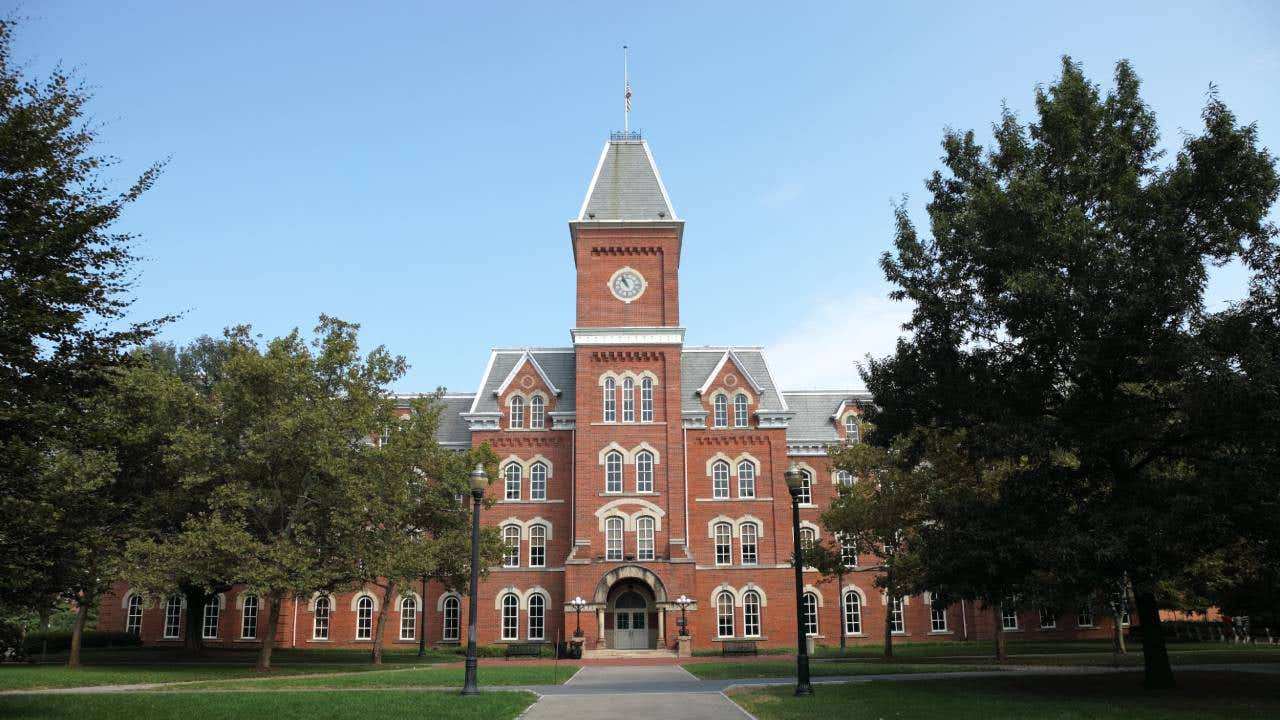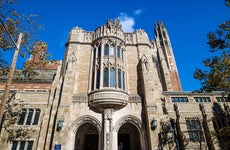Best value law schools in 2024

The Bankrate promise
At Bankrate we strive to help you make smarter financial decisions. While we adhere to strict , this post may contain references to products from our partners. Here's an explanation for .
Becoming a lawyer can be a rewarding but expensive path. On average, young lawyers leave school with over $100,000 worth of debt, according to the American Bar Association (ABA).
Bankrate’s editorial team evaluated over 190 law schools across the nation to find which ones provide students with an excellent education at an affordable price. The schools featured on this list have high bar exam pass rates, robust financial aid packages and lower-than-average graduate loan disbursements. They also have a high rate of students securing jobs within 10 months of graduation.
Bankrate’s 2024 list of best value law schools
Arizona State University
- Students who paid full tuition: 7.90%
- Average graduate loan disbursement: $96,603
- Average bar exam pass rate: 86.44%
- Students employed 10 months after graduation: 88.90%
Located in the heart of downtown Phoenix, the Sandra Day O’Connor College of Law is as diverse as its surroundings. The 2023-24 entering class has students from 34 states, 11 countries and 135 universities.
Students get access to a series of experiential learning programs, including 10 legal clinics, as well as externships and a moot court. This last one offers students the opportunity to polish their litigation skills through simulated trials.
ASU also has eight law centers, including the American Indian Policy Institute, which has been recognized internationally, and the Center for Constitutional Design.
Saint Louis University
- Students who paid full tuition: 1.50%
- Average graduate loan disbursement: $99,116
- Average bar exam pass rate: 86.74%
- Students employed 10 months after graduation: 86.40%
Saint Louis University School of Law is the oldest of its kind west of the Mississippi River. The school, founded in 1843, has a series of dual degrees, in addition to its traditional JD curriculum. These programs allow students to earn a master’s in areas like accounting, business administration and social work along with their JD.
The school also offers a special two-year law program for foreign lawyers. Aside from outstanding academics, Saint Louis takes pride in offering generous financial aid packages to students. In fact, 98.5 percent of students didn’t pay full sticker price in 2022.
Temple University
- Students who paid full tuition: 9.50%
- Average graduate loan disbursement: $87,831
- Average bar exam pass rate: 85.15%
- Students employed 10 months after graduation: 86.20%
Temple University Beasley School of Law has probably one of the best locations for prospective lawyers on this list. The school is located in Philadelphia and surrounded by state and federal courts and numerous law firms. That means students have access to a wealth of learning and job opportunities.
The JD programs at Temple University feature specializations in civil rights law, international law, trial advocacy and public interest and social justice, among others. Students can also choose from a variety of clinics and practicums for a well-rounded experience.
The Ohio State University
- Students who paid full tuition: 6.50%
- Average graduate loan disbursement: $83,831
- Average bar exam pass rate: 90.66%
- Students employed 10 months after graduation: 86.10%
The Ohio State University is one of the largest universities in the country. However, the Moritz College of Law has under 600 students. The school is located in OSU’s Drinko Hall, which is also the home of Ohio’s largest law library.
Moritz has eight clinics to choose from, one of them being its legislation clinic. This clinic offers students the opportunity to work directly with legislative leaders of the Ohio General Assembly, assisting them with research, analysis and the monitoring of the lawmaking process.
The more than 11,000 alumni from Moritz include justices of the Supreme Court of Ohio, U.S. senators and representatives, in addition to governors and other pillars of the legislative community.
University of Alabama
- Students who paid full tuition: 8.90%
- Average graduate loan disbursement: $62,337
- Average bar exam pass rate: 91.30%
- Students employed 10 months after graduation: 89.30%
The University of Alabama School of Law is located in the city of Tuscaloosa, near historic sites, antebellum homes, restaurants and more. The school has an ample curriculum, which includes a variety of dual programs, such as a JD/MBA program. Students also get access to various public interest law clinics in areas like civil law, domestic violence law and criminal defense law. However, one of the school’s most notable features is that it regularly places among the top 10 law schools in the country where students receive federal judicial clerkships.
University of Minnesota
- Students who paid full tuition: 12.60%
- Average graduate loan disbursement: $90,393
- Average bar exam pass rate: 89.55%
- Students employed 10 months after graduation: 86.80%
The University of Minnesota Law School has the nation’s largest clinical education program with 28 clinics to choose from. Law students can also pick from 11 concentrations, including human rights law, labor and employment law, business law and immigration law. The school also features a prime location in the Twin Cities where there’s no shortage of sights to see and activities to do.
For those who want to stay in the city after graduation, there’s plenty of opportunities to do that. The school not only offers a variety of externships within the city, but prospective employers frequently visit Minnesota Law looking for candidates.
University of Utah
- Students who paid full tuition: 10.80%
- Average graduate loan disbursement: $89,762
- Average bar exam pass rate: 93.98%
- Students employed 10 months after graduation: 88.90%
Founded in 1913, the University of Utah S.J. Quinney College of Law boasts state-of-the-art facilities and cutting-edge law programs. The school has four research centers and programs, the most notable one being the Wallace Stegner Center for Land, Resources and the Environment. This center has been recognized for offering one of the top programs in the nation in environmental and natural resources law.
The school also takes pride in pioneering initiatives. Its latest one being the Pro Bono Initiative at the Utah State Correctional Facility. Under this initiative, students get the chance to volunteer and help incarcerated individuals with legal issues that aren’t related to criminal convictions.
Wake Forest University
- Students who paid full tuition: 11.40%
- Average graduate loan disbursement: $82,416
- Average bar exam pass rate: 93.26%
- Students employed 10 months after graduation: 89.80%
Wake Forest School of Law offers students a combination of learning opportunities through eight clinics, journals, externships and several pro bono projects. It is also the home to a North Carolina Business Court, which means students get a front-row seat to corporate hearings and commercial law disputes.
Winston-Salem in North Carolina, where the school is located, is well known for its diverse business environment in areas like financial services and technology. This gives students plenty of opportunities to practice business law firsthand.
Washington University in St. Louis
- Students who paid full tuition: 3.50%
- Average graduate loan disbursement: $96,928
- Average bar exam pass rate: 91.93%
- Students employed 10 months after graduation: 90.20%
Founded in 1867, Washington University School of Law has a rich history in addition to great academics. In 1869, it was the first chartered law school in the U.S. to admit women.
The school’s clinical education program is also considered one of the best in the country. Students can choose from 19 professional practice opportunities, including some outside of the U.S. It also offers 12 JD concentrations, including family, gender and sexuality law, social justice and legal theory and constitutional law and civil rights.
How to pay for law school
According to data by Law School Transparency, in 2023, resident students at public law schools paid an average of $30,554 a year in tuition and fees, while nonresident students paid an average of $43,590. Students at private schools paid even more, with an average of $55,963. Needless to say, paying for law school can be a tall order. Still, there are a few options you can explore to make the costs more manageable.
Scholarships or grants
Both scholarships and grants are a form of gift aid, meaning that you don’t have to pay them back. Because of this, they should be your first option to help you pay for school. You can find many scholarships and grants for law students on the Law School Admission Council website or by using a scholarship search engine.
Fellowship or assistantship programs
Most law schools offer outstanding students fellowship or assistantship opportunities. This allows students to work a certain number of hours in exchange for monetary compensation or other benefits, like reduced tuition. However, these are highly competitive and require a large time commitment, which is something to keep in mind.
Federal student loans
Law students are eligible for Direct Unsubsidized and Grad PLUS loans. These federal student loans currently have a fixed interest rate of 7.05 and 8.05 percent, respectively. Unlike Direct Loans, Grad PLUS loans require students to pass a credit check, but if you’re approved, you can borrow an amount equal to your full cost of attendance. Direct Unsubsidized loans have an annual cap of $20,500 for graduate students.
If you need to borrow money for school, federal student loans should always be your first choice, as you’ll have access to benefits, such as income-driven repayment plans. Other benefits that are not available to private student loan borrowers include student loan forgiveness programs.
Private student loans
Private student loans can have fixed or variable interest rates ranging from roughly 4.10 percent up to 16 percent. Although the rates can be lower than federal student loans, you’ll need to have excellent credit or a creditworthy co-signer to secure the best rates.
Methodology
To find the best value law schools of 2024, Bankrate evaluated over 190 law schools in four key areas: bar exam pass rates, percentage of students who paid full tuition, average graduate loan disbursement amount and percentage of students who were employed 10 months after graduation.
Bar exam pass rates
Bar pass rates are directly linked to good alumni outcomes. According to ABA, 77.8 percent of the class of 2022 is employed in full-time, long-term jobs that required them to pass the bar exam. Our list features schools where 86 percent or more of first-time takers passed the bar in 2023.
Percentage of students who paid full tuition
In a recent survey by ABA, roughly 90 percent of respondents said they had to borrow money to pay for their JD degree and owed over $100,000, on average. This is why we eliminated schools where over 13 percent of students have to pay full-sticker price, prioritizing those with more ways to save.
Average graduate loan disbursement
How much you borrow to pay for school can have long-lasting effects on your future finances and hinder you from achieving important milestones, like buying a house or starting a family. For that reason, we favored schools where students have taken out less than $100,000 in law school loans — lower than the average law school debt amount, according to ABA.
Percentage of students who were employed 10 months after graduation
Alumni’s abilities to secure employment shortly after graduating is a measure of program success. Our list features schools where 86 percent or more graduates were employed at least 10 months after graduation.
Related Articles



